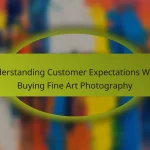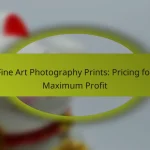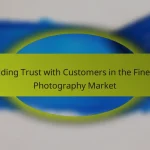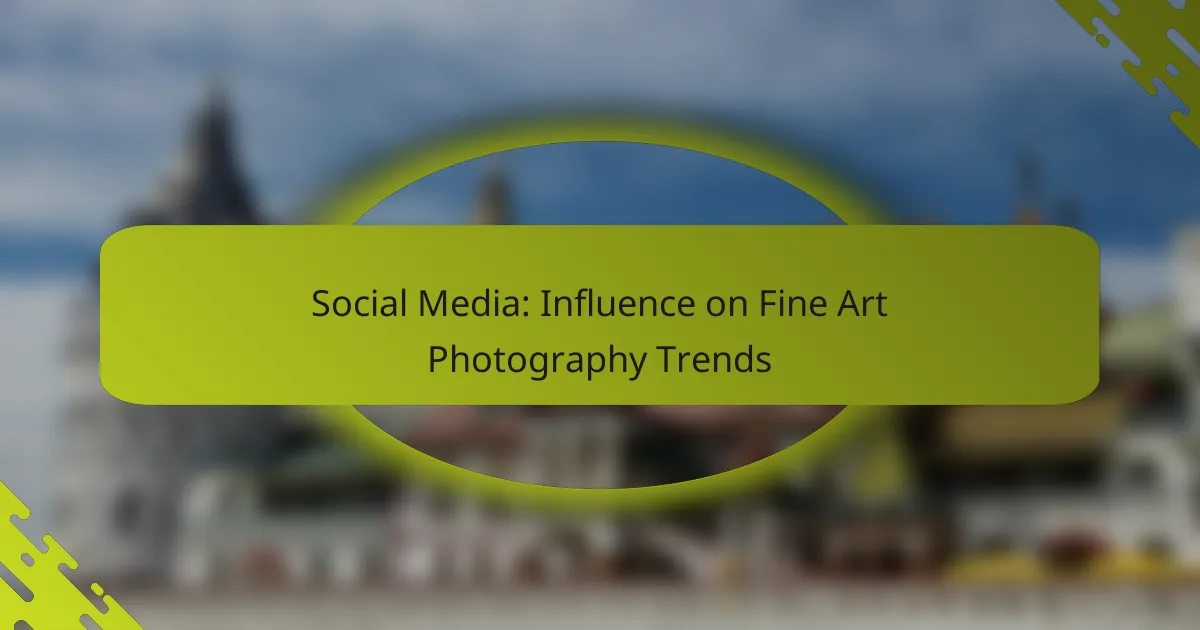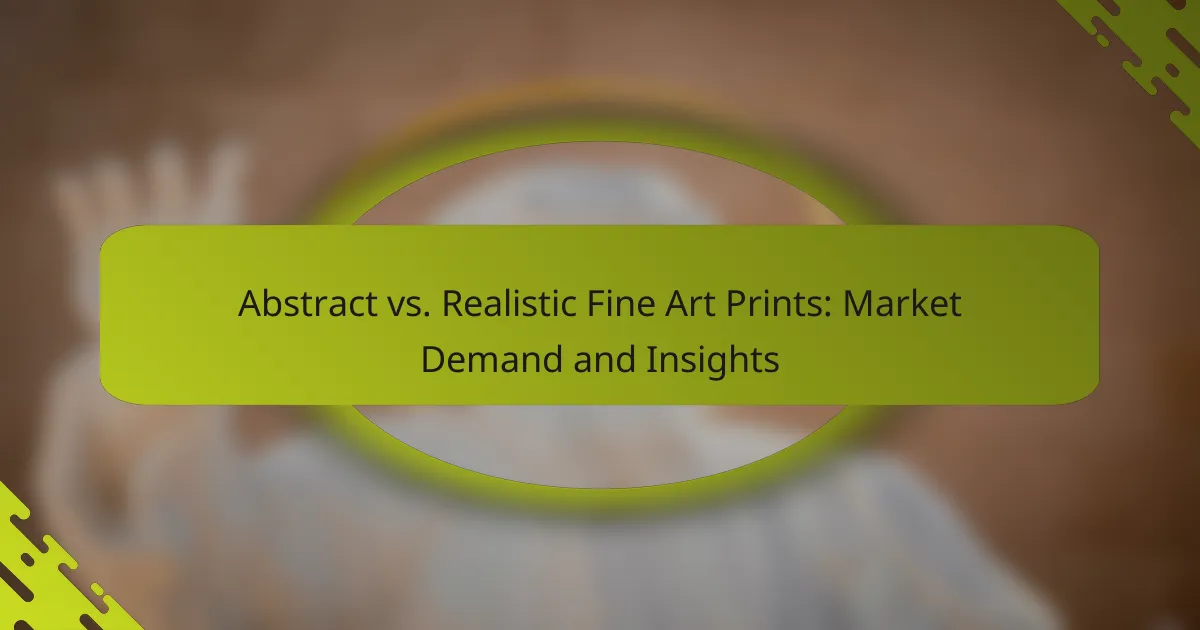In the ever-evolving world of fine art photography prints, staying ahead of trends is essential for collectors and enthusiasts alike. Current trends emphasize unique styles and thematic depth, with a growing interest in innovative techniques that reflect contemporary issues. Understanding personal taste and the artist’s vision is crucial when selecting pieces that resonate emotionally and aesthetically.
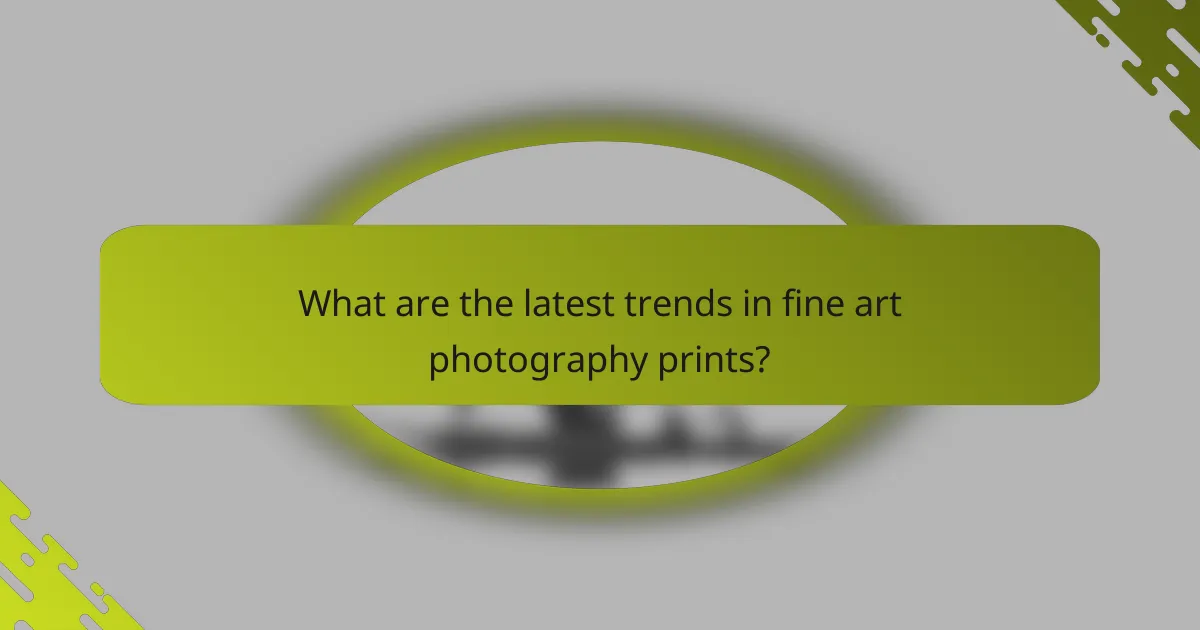
What are the latest trends in fine art photography prints?
The latest trends in fine art photography prints focus on unique styles, thematic depth, and the impact of digital platforms. Collectors are increasingly drawn to innovative techniques and narratives that resonate with contemporary issues and personal experiences.
Emerging styles in 2023
In 2023, emerging styles in fine art photography include a blend of traditional techniques with modern technology. Photographers are experimenting with mixed media, incorporating elements like digital manipulation and collage to create layered narratives.
Another notable trend is the rise of large-format prints that emphasize detail and texture. These oversized pieces often serve as statement artworks in both private and public spaces, attracting attention for their visual impact.
Popular themes among collectors
Collectors are gravitating towards themes that explore identity, nature, and social commentary. Works that reflect personal stories or address global issues tend to resonate more, as they foster a deeper connection with viewers.
Additionally, sustainability is becoming a significant theme, with many photographers focusing on environmental issues. Art that highlights the beauty of nature or critiques its degradation is increasingly sought after, aligning with collectors’ values.
Influence of social media on trends
Social media platforms play a crucial role in shaping trends in fine art photography. Artists use these platforms to showcase their work, gain visibility, and connect with potential buyers, which can rapidly influence popular styles and themes.
Moreover, the viral nature of social media allows for niche trends to emerge quickly. For instance, a specific aesthetic or concept can gain traction overnight, leading to increased demand for prints that embody those characteristics.
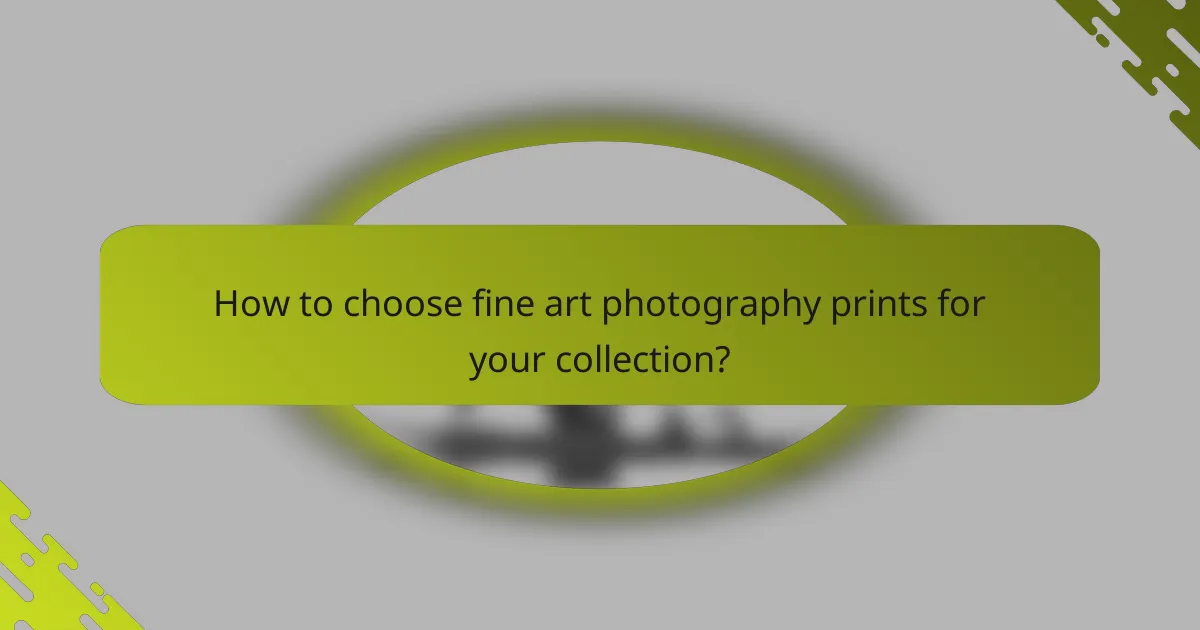
How to choose fine art photography prints for your collection?
Choosing fine art photography prints for your collection involves understanding your personal taste, the artist’s vision, and the print’s quality. Focus on elements such as subject matter, style, and the emotional impact of the artwork to ensure it resonates with you.
Factors to consider when selecting prints
When selecting fine art photography prints, consider the print’s size, framing options, and the medium used. Larger prints can serve as focal points in a room, while smaller pieces may complement existing decor. Additionally, choose between traditional paper prints, canvas, or metal for different aesthetic effects.
Evaluate the artist’s reputation and the print’s provenance. Limited editions often hold more value and can be a wise investment. Ensure that the print is produced using archival materials to guarantee longevity and prevent fading over time.
Popular artists and their signature styles
Many contemporary photographers have made significant impacts in the fine art world. Artists like Ansel Adams are known for their breathtaking landscapes and mastery of black-and-white photography, while Cindy Sherman explores identity and gender through conceptual portraits.
Other notable names include Gregory Crewdson, who creates cinematic scenes that blend reality and fantasy, and Andreas Gursky, recognized for his large-scale, vibrant images of modern life. Familiarizing yourself with these artists can help you identify styles that resonate with your personal collection goals.
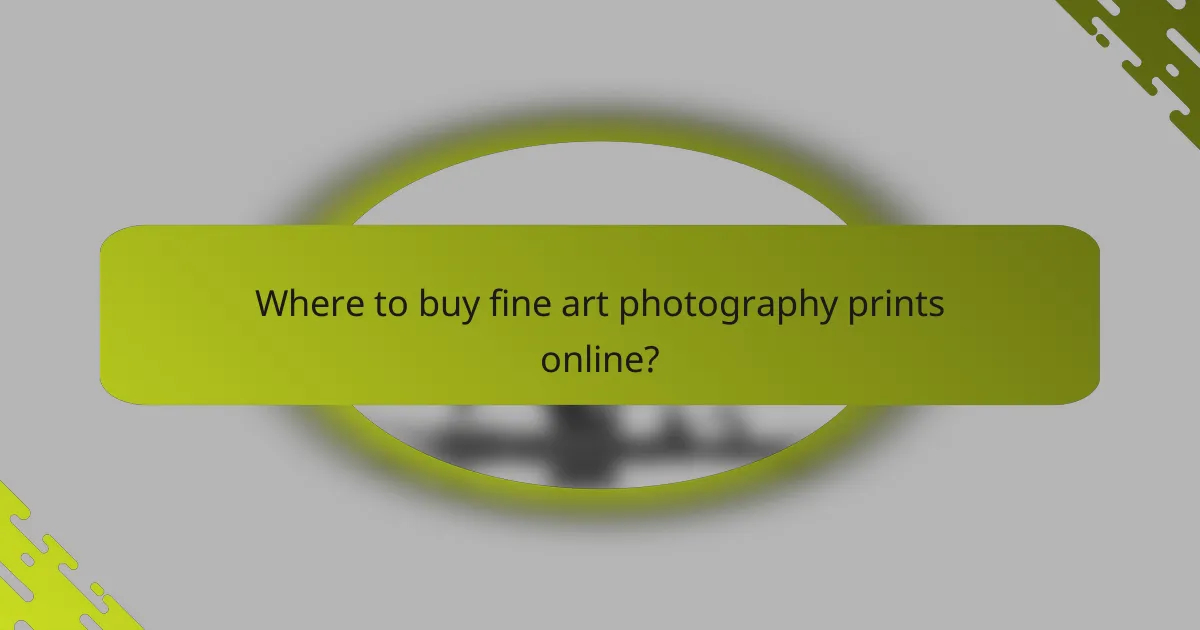
Where to buy fine art photography prints online?
You can buy fine art photography prints online through various e-commerce platforms, local galleries, and specialized art websites. These options offer a range of styles, prices, and quality, making it easier to find the perfect piece for your collection or decor.
Top e-commerce platforms for art prints
Popular e-commerce platforms like Etsy, Saatchi Art, and Artfinder provide extensive selections of fine art photography prints. These sites often feature works from emerging artists, allowing you to discover unique pieces at various price points, typically ranging from affordable to high-end.
When purchasing from these platforms, consider factors such as print quality, artist reputation, and shipping costs. Many sites offer customer reviews and ratings, which can help you make informed decisions.
Local galleries offering online sales
Many local galleries have adapted to the digital age by offering online sales of fine art photography prints. These galleries often showcase local artists and provide a more personalized shopping experience, which can enhance your connection to the artwork.
Check the websites of galleries in your area for online exhibitions and purchasing options. This not only supports local artists but also ensures that you receive quality prints, often with the option for framing or other customizations.
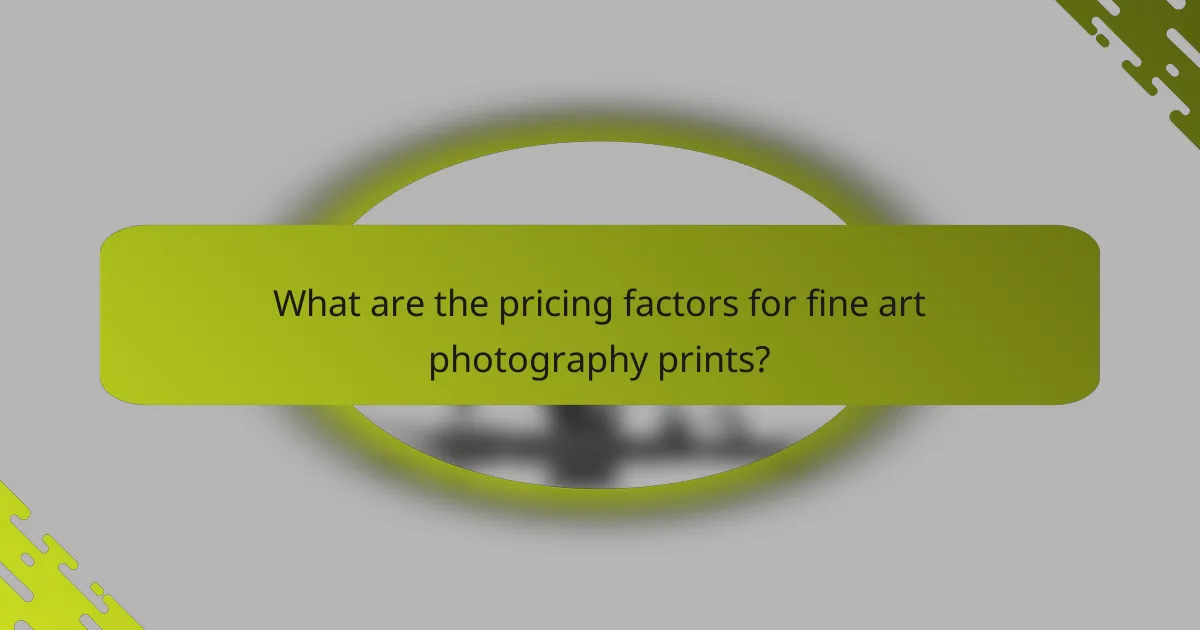
What are the pricing factors for fine art photography prints?
The pricing of fine art photography prints is influenced by several key factors, including the artist’s reputation, print size, materials used, and the edition type. Understanding these elements can help buyers make informed decisions and appreciate the value of the artwork.
Factors influencing print pricing
One of the primary factors affecting print pricing is the artist’s reputation and market demand. Established artists typically command higher prices due to their recognition and previous sales history. Additionally, the uniqueness of the print, such as whether it is part of a limited edition or an open edition, also plays a significant role in determining its price.
The materials used in the printing process, including the type of paper and ink, can significantly impact costs. High-quality archival paper and pigment-based inks tend to be more expensive but offer better longevity and visual appeal. Furthermore, the printing method, such as giclée or traditional darkroom prints, can also affect pricing.
Price ranges for different print types
Fine art photography prints can vary widely in price based on their type. For example, open edition prints may start from around $50 to $200, while limited edition prints can range from $200 to several thousand dollars depending on the artist and size. Original prints created through traditional methods may command even higher prices due to their uniqueness.
As a general guideline, smaller prints (e.g., 8×10 inches) typically fall on the lower end of the pricing spectrum, while larger prints (e.g., 24×36 inches) can significantly increase in cost. Buyers should also consider framing options, which can add an additional $100 to $500 or more to the overall price, depending on the materials and craftsmanship involved.

How to care for fine art photography prints?
Caring for fine art photography prints involves protecting them from environmental factors that can cause damage. Proper handling, storage, and display techniques are essential to maintain their quality and longevity.
Best practices for preservation
To preserve fine art photography prints, keep them in a stable environment with controlled temperature and humidity levels. Ideally, temperatures should be between 18-24°C (65-75°F) and humidity levels around 40-50%. Avoid direct sunlight, which can fade colors and degrade materials over time.
Store prints in acid-free sleeves or boxes to prevent exposure to pollutants and moisture. Regularly check for signs of deterioration, such as fading or discoloration, and handle prints with clean, dry hands to avoid transferring oils or dirt.
Recommended framing options
When framing fine art photography prints, use UV-protective glass to shield against harmful light. Choose frames made from wood or metal that are sturdy yet lightweight, ensuring they complement the artwork without overwhelming it.
Consider using a mat board to create a space between the print and the glass, which helps prevent sticking and allows for air circulation. Opt for acid-free materials to avoid chemical reactions that could damage the print over time.
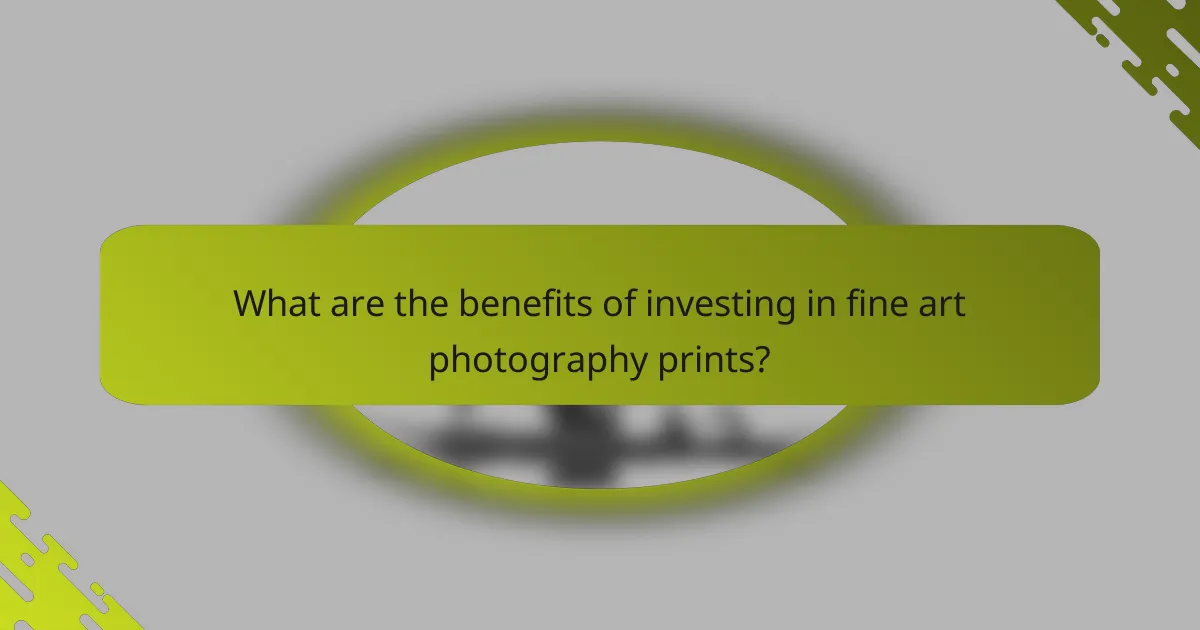
What are the benefits of investing in fine art photography prints?
Investing in fine art photography prints offers both aesthetic enjoyment and potential financial returns. These prints can enhance your living space while appreciating in value over time, making them a dual-purpose investment.
Long-term value appreciation
Fine art photography prints can appreciate significantly over time, especially if the artist gains recognition. Collectors often see value increases ranging from low double digits to over 50% in a decade, depending on the artist’s market presence and the print’s rarity.
When investing, consider the artist’s track record, exhibition history, and critical acclaim. Limited editions typically hold more value than open editions, so prioritize acquiring prints that are part of a defined series.
Enhancing home decor
Fine art photography prints serve as striking focal points in any room, elevating the overall decor. They can complement various styles, from modern to traditional, and can be used to convey personal taste and aesthetic preferences.
When selecting prints for home decor, consider the color palette and theme of your space. Large, bold pieces can create a dramatic impact, while smaller prints can be grouped for a gallery wall effect, adding depth and interest to your environment.
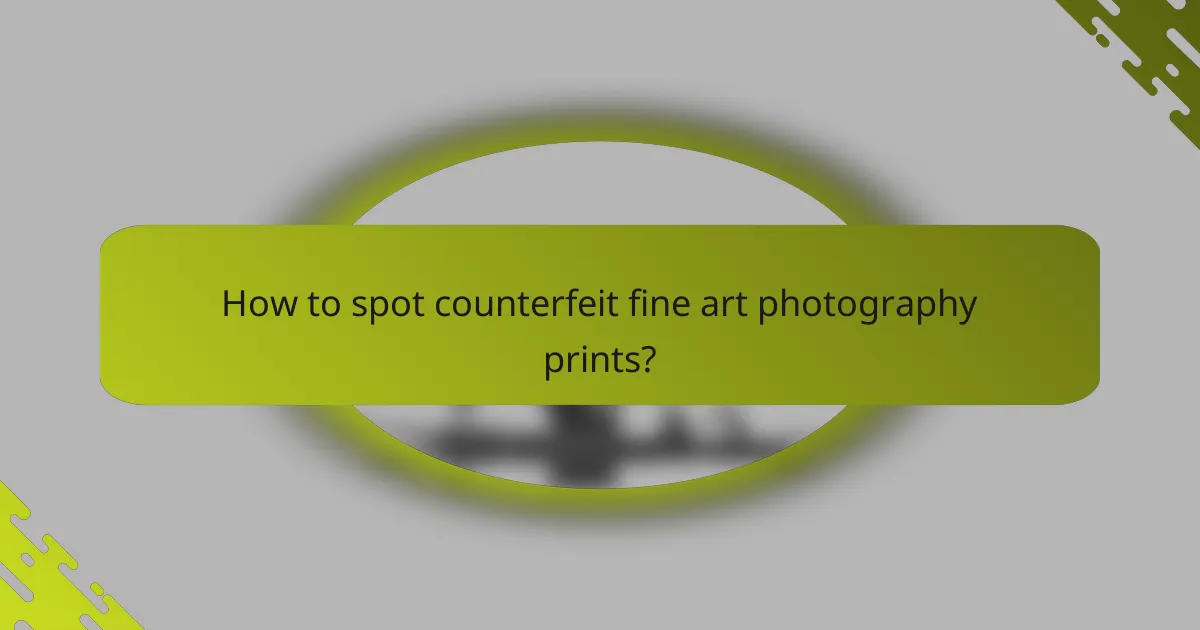
How to spot counterfeit fine art photography prints?
To spot counterfeit fine art photography prints, examine the print’s quality, provenance, and any accompanying documentation. Authentic prints typically have a high level of detail, proper signatures, and certificates of authenticity.
Check the print quality
High-quality fine art photography prints should exhibit sharp details and accurate color reproduction. Look for prints made using archival inks and papers, as these materials enhance longevity and visual appeal. If the print appears pixelated or the colors seem dull, it may be a counterfeit.
Examine the signature and edition
Authentic prints often feature the artist’s signature, which should be consistent with their known signature style. Additionally, check for edition numbers; limited editions are typically more valuable. A print without a signature or edition number may raise red flags regarding its authenticity.
Review provenance and documentation
Provenance refers to the history of ownership of the artwork. Reliable documentation, such as certificates of authenticity or gallery receipts, can help verify a print’s legitimacy. If the seller cannot provide this information, consider it a warning sign.
Consult experts or appraisers
If you’re uncertain about a print’s authenticity, seek the opinion of a qualified art appraiser or expert. They can provide insights based on their experience and knowledge of the market. Investing in expert advice can save you from costly mistakes.


